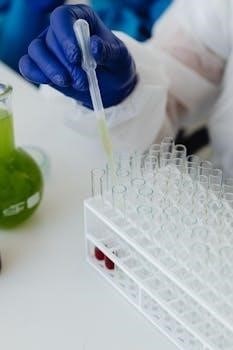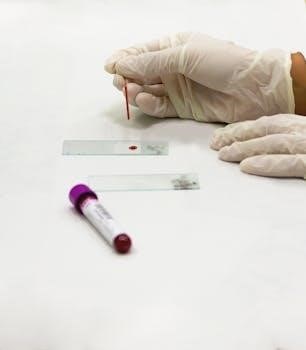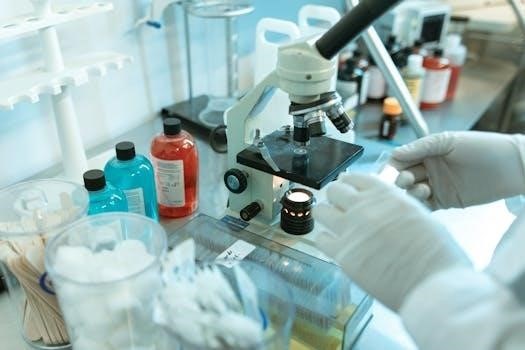scientific method worksheet with answers pdf
Scientific Method Poster and Visual Terms
This section provides a printable poster for classroom use, highlighting key scientific method terms. The visual aid includes the “Purpose,” which defines the question or problem under investigation. The poster can be laminated for extended use.
Purpose⁚ Defining the Question or Problem
The initial step in any scientific endeavor involves clearly articulating the research question or identifying the specific problem that needs to be addressed. This foundational stage sets the direction for the entire investigation. A well-defined purpose acts as a compass, guiding the researcher towards relevant observations, data collection, and analysis. Without a clear research question, the subsequent steps of the scientific method will lack focus and may lead to irrelevant conclusions. This stage is critical for ensuring the scientific process remains rigorous and effective in its quest for knowledge. The goal is to formulate a testable question that can be investigated through experimentation.
Scientific Method Variables
This section focuses on understanding variables within the scientific method. It includes identifying independent, dependent, and control variables, crucial for designing effective experiments. Worksheets help reinforce these concepts.
Worksheet on Identifying Variables
This worksheet provides exercises to practice identifying different types of variables in experiments. Students will learn to distinguish between the independent variable, which is manipulated, the dependent variable, which is measured, and the control variables, which are kept constant. This practice is essential for understanding how to design and interpret scientific investigations. The worksheet may include various scenarios and examples, helping students apply their knowledge in practical situations. By completing these exercises, students will gain a deeper understanding of the role variables play in the scientific method.
Bart Simpson Controls and Variables
This section features a worksheet using Bart Simpson scenarios to identify controls and variables. An answer key is provided for educators to easily assess student understanding of these concepts.
Worksheet with Answer Key
This worksheet provides practice in identifying control and variable components within a scientific experiment. The worksheet includes scenarios requiring students to distinguish between independent, dependent, and control variables. Also, included is a comprehensive answer key. This key is designed to aid teachers in efficiently grading student responses and providing immediate feedback. The answer key ensures clarity and helps students grasp the nuances of experimental design and data analysis. This resource is ideal for reinforcing the essential skills needed for scientific inquiry.
Scientific Method Test Document
This document contains information about scientific terms and applying the scientific method. It includes examples and test questions to evaluate understanding of the scientific process.
Information on Scientific Terms and Application
This section details important scientific terms related to the scientific method, such as independent and dependent variables, control groups, and standardized variables. It also focuses on the application of the scientific method, providing examples of how to use these terms in real-world experiments. Understanding these terms and their application is crucial for conducting and analyzing experiments effectively. This helps students to grasp the process and apply it to various scientific studies. The section also emphasizes the importance of accurate observations and data collection.
Scientific Method Steps
This section outlines the core steps of the scientific method⁚ observation, problem, hypothesis, materials, procedure, experiment, analysis, and conclusion. Each step is crucial for a structured scientific investigation.
Observation, Problem, Hypothesis, Materials, Procedure, Experiment, Analysis, Conclusion
The scientific method begins with careful observation, leading to a defined problem. A testable hypothesis is then formulated. Next, a list of necessary materials is compiled. A detailed procedure guides the experiment, which is followed by a thorough analysis of the results. Finally, a conclusion is drawn, based on the analysis, to answer the initial question. This structured approach ensures a rigorous and organized scientific investigation process. This section provides a detailed breakdown of each of these crucial steps.

Observations vs Inferences
This section differentiates between observations, which are direct sensory perceptions, and inferences, which are interpretations of those observations. Understanding this distinction is key to scientific analysis.
Key Differences Explained
Observations are factual statements obtained through the senses, like seeing, hearing, or touching. They are direct and objective, describing what is immediately perceived. In contrast, inferences are conclusions or interpretations drawn from observations. They go beyond what is directly sensed, involving reasoning and assumptions. For example, seeing a wet street is an observation; inferring it rained is an interpretation. Distinguishing between these is crucial for accurate scientific analysis and forming valid conclusions. This distinction helps avoid mixing factual data with assumptions.

Scientific Method Worksheet PDF
This section features a downloadable PDF worksheet focusing on the scientific method. It includes a drug testing example, where volunteers are given a new drug or a placebo.
Example with Drug Testing
A pharmaceutical company conducted a trial to test a new cold medicine on 50 volunteers. Half received the new drug, while the other half received a placebo. The effectiveness of the drug was measured by the number of tissues each person used over a seven-day period. This example is used to demonstrate the application of the scientific method, including observation, variable control, and data analysis. It provides a real-world scenario for students to understand how experiments are structured and analyzed when testing new medications.

Free Printable 7th Grade Science Worksheet
This section provides a free, printable worksheet tailored for 7th-grade science students. It includes practice questions on the scientific method, along with an answer key for easy assessment.
Practice Questions with Answer Key
This section offers practice questions designed to reinforce understanding of the scientific method. These questions are specifically tailored for students learning about the scientific method. The exercises encourage application of the scientific method’s steps, such as forming a hypothesis and analyzing data. An answer key is included, facilitating self-assessment and providing immediate feedback. The inclusion of a detailed answer key promotes student learning and understanding. These practice questions are designed to be challenging and thought-provoking, enhancing critical thinking skills while assessing knowledge of the scientific method.

Scientific Method Practice Worksheet Key
This section provides the answer key for the scientific method practice worksheet. It is available for download in various formats, including PDF, DOC and text files. This key helps in self-assessment.
Downloadable in various formats
The scientific method practice worksheet key is conveniently available for download in multiple formats to suit different user needs. You can access the answer key in commonly used formats such as PDF, Word Doc (.doc), and plain text files (.txt). This flexibility ensures that educators and students can easily utilize the resource regardless of their preferred software or device. The downloadable formats allow for easy printing, editing, and sharing of the answer key, making it a versatile tool for both classroom and home learning environments. This variety supports seamless integration into existing teaching and study practices. The availability in several formats facilitates ease of use and accessibility for a wider range of users.
Key Aspects of a Hypothesis
A strong hypothesis must answer the initial research question and be testable. This means it should be possible to design an experiment to gather evidence and evaluate its validity.
Answering the Question and Being Testable
A crucial element of a well-formed hypothesis is its ability to directly address the research question. Furthermore, it absolutely must be testable through experimentation, observation, and data collection. This testability allows scientists to gather evidence that either supports or refutes the hypothesis, contributing to a deeper understanding. The hypothesis should provide a clear prediction that can be examined using scientific methods. If a hypothesis cannot be tested through experiments, it is not useful in the scientific process.